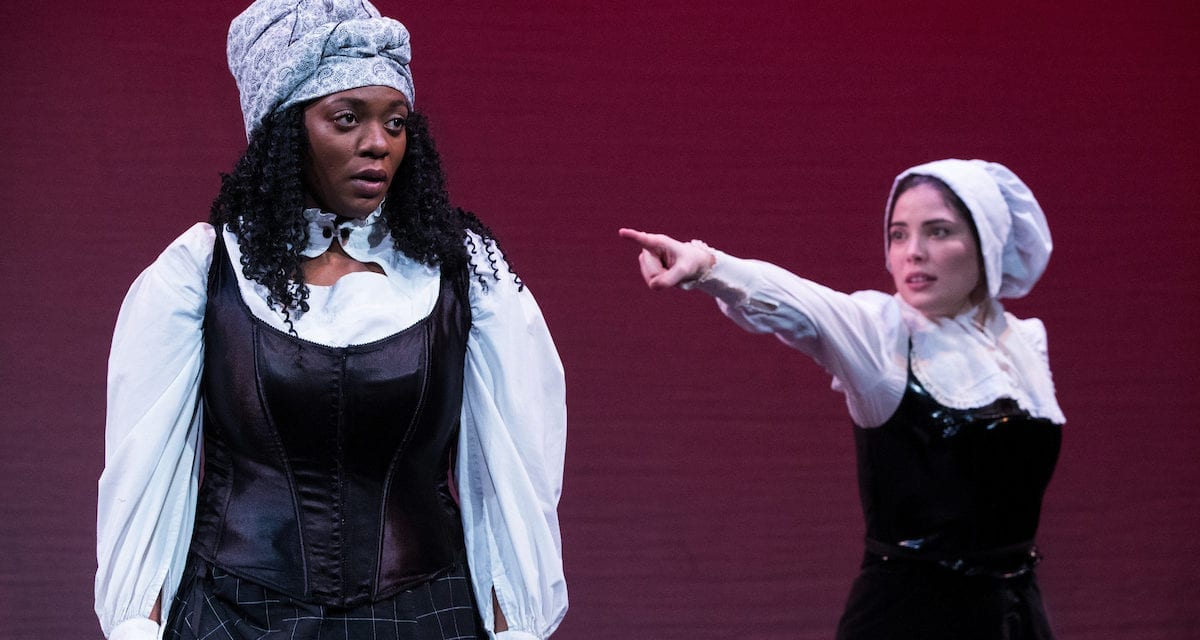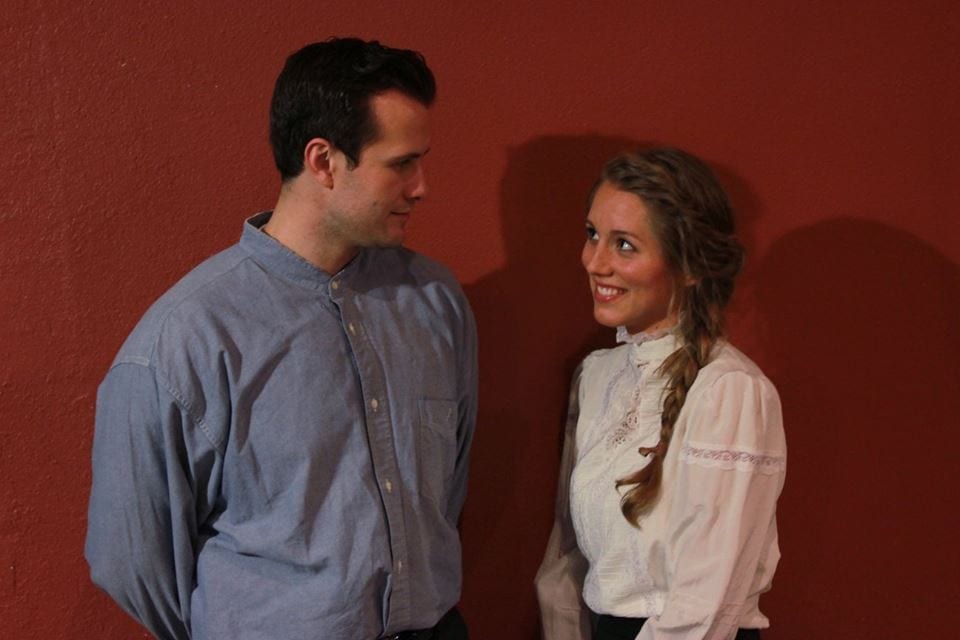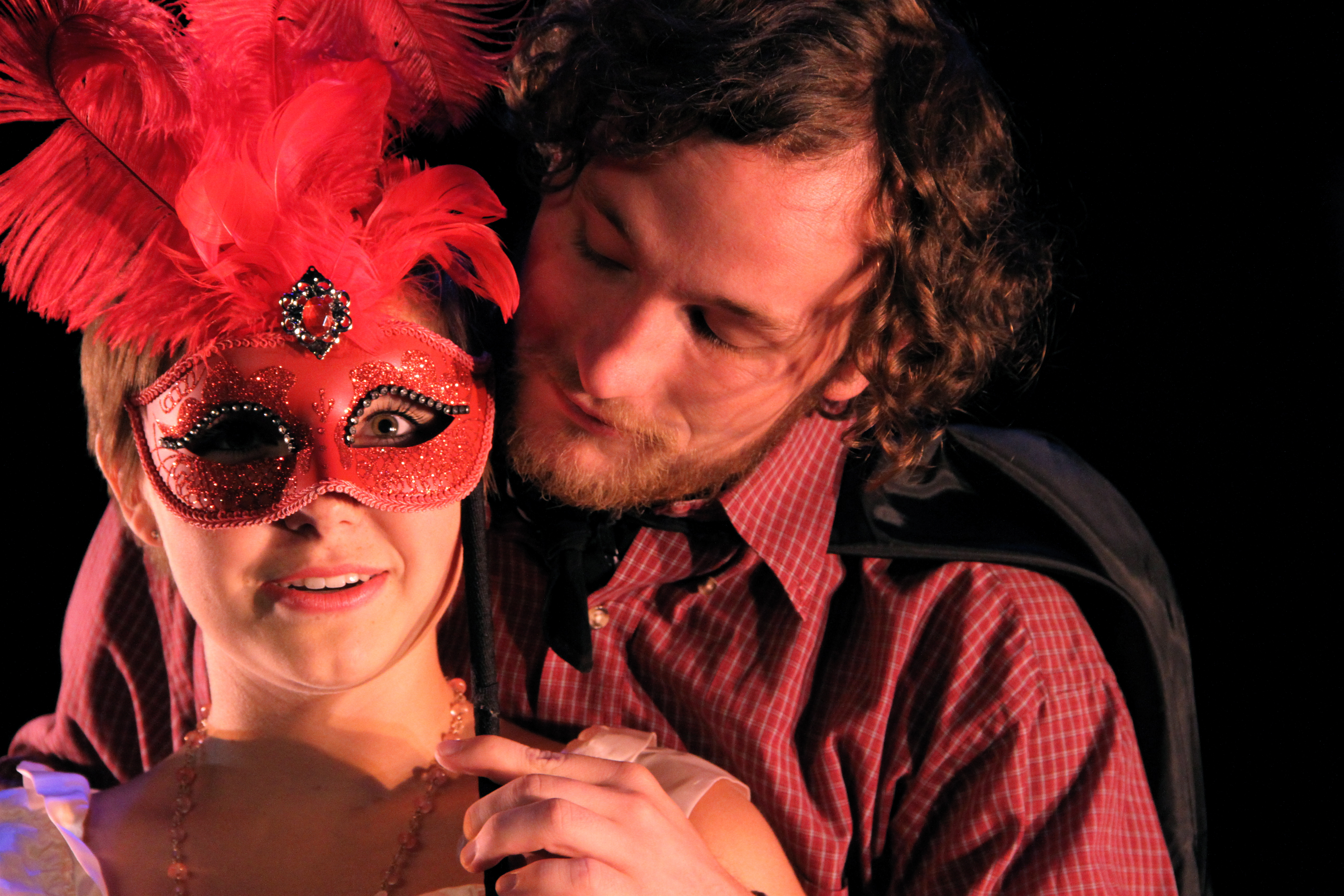PROVO — The Crucible by Arthur Miller is a contemporary theatre classic. On the surface The Crucible is a play about the Salem Witch Trials. Young, puritan girls accusing their neighbors of witchcraft. People undergoing suspicion, trials, imprisonment, and even execution. There are many ways to interpret and relate to The Crucible, and Brigham Young University’s production was no exception.

Show closes April 8, 2017.
As I entered the small black box theatre I was met with a black wall of white script. I also noticed small tables with half masks, not a normally used prop for this play. In the moments before the production started, I perused the program to see if I could learn anything about the masks. The program stated the director, David Morgan, had a goal “to help the audience understand the layers and masks that people—specifically the Puritan characters in this show—use to hide their true selves. The person you see isn’t presenting who they really are. The truth is beneath the mask.” I was extremely interested to see how well this goal would be met.

Photo by Jaren Wilkey/BYU.
The masks worked extremely well in some moments. I felt they were effective in the opening scene where Reverend Samuel Parris (played by Spencer Hunsicker) is praying over his catatonic daughter, Betsy (Jessica Ashby). This was one of the few moments where the audience can see Parris’s real face. In this moment he is a caring, concerned father, but as soon as others entered the room his mask was back on. Another instance where the masks worked well was when Abigail has a rendezvous with John Proctor in the woods at night. Initially, she is on her guard with a mask on, but after awhile the mask comes off as she seeks to be more intimate with Proctor and asks him, “Can you see my face?”
Yet, there were other moments where I felt that masks were inconsistent in their use. For example, in the opening scene Betsy is wearing a mask as she pretending to be ill, but later when the girls are pretending to be afflicted by spirits they aren’t wearing masks. John Proctor is the only one maskless in most scenes, perhaps because he is open and honest, and doesn’t feel the needs to hide his true self. I felt that there are other characters who should also have remained maskless, such as Rebecca Nurse (Chelsea Mortensen) and Giles Corey (Franco Acosta). Overall, I felt that the use of masks, although good in theory, was distracting from the actual performance as I was trying to analyze why masks were on or off.

Photo by Jaren Wilkey/BYU.
Although the artistic choice to use masks didn’t work, I confess that there was not a weak link in this cast. Abbie Martschenko played Abigail Williams as sly and manipulative. Abigail was a girl who knew was she wanted and wasn’t afraid to go to any length to try and get it. She has a tragic past (her parents were murdered by Indians beside her in bed) and is a bit wild. She is no fool however. Even behind her mask, I could see her taking note as the adults discussed witches in her forgotten presence. Abigail is leader among the other girls, a leader who is not to be defied. She will only listen to her own wants and desires, which means she will listen to John Proctor.
John Proctor, played by Tyler Hatch, is a strong man who values his integrity above all else. He isn’t a perfect man, and his past mistakes follow closely at his heels. Proctor never claims to be perfect, but he tries to amend his mistakes. His relationship with his wife, Elizabeth (played by Mariah Bowles), goes through so many emotions and levels. In the beginning the relationship is strained because of John’s affair with Abigail months earlier, but their experiences throughout the production cause them to grow together in a way that is heart-wrenching in the final scenes.

Photo by Jaren Wilkey/BYU.
Besides the principle characters of John Proctor, Abigail Williams, and Elizabeth Proctor, a few other characters stood out, including Reverend Samuel Parris. Reverend Parris was more despicable to me in this production of The Crucible than in other that I’ve experienced. I love when a performer of a disliked character does the job so well that I feel disgust at the sight of them. So many times, especially during the courtroom scenes I wanted to pluck Parris out of the room and throw him out of the court. He was so manipulative and self centered, I could easily understand why John Proctor hadn’t taken a shining to him. I loved the side by side contrast of the judges, Danforth (Paul DeWitt) and Hawthorne (Taycen Timothy). Danforth managed to bring a wise, sagely presence despite some flaws in the experienced man’s views. It was easy to see why many people took his word as final. His pride came from years of respect and success. Hawthorne, on the other hand, appeared smug and proud just because he held a position of power. He didn’t even try to appear as if he was listening to those people in his court. He passed judgement from the start.
I loved the simplicity of the set design (by Rachel Bowerbank) and props (by Taylor Robinson). The designs reflected this simplicity the Puritans lived in and balanced the complexity of the story. This production was quite black and white in its designs, with an occasional pop of color to help emphasis a specific moment or idea. However, there were a few selections in the costume pieces, such as Hale’s belt or Abigail’s pleather bodice, that felt out of place with the rest of Deanne DeWitt’s costume designs.
This production of The Crucible was a mixed bag for me. I loved the performance of the actors, but some of the artist choices distracted from what the performers were doing. Although I didn’t love the use of masks, I did enjoy seeing a new interpretation that had me continually asking questions and analyzing. If you love a strong cast performing a moving drama this production of The Crucible is well worth your time.





